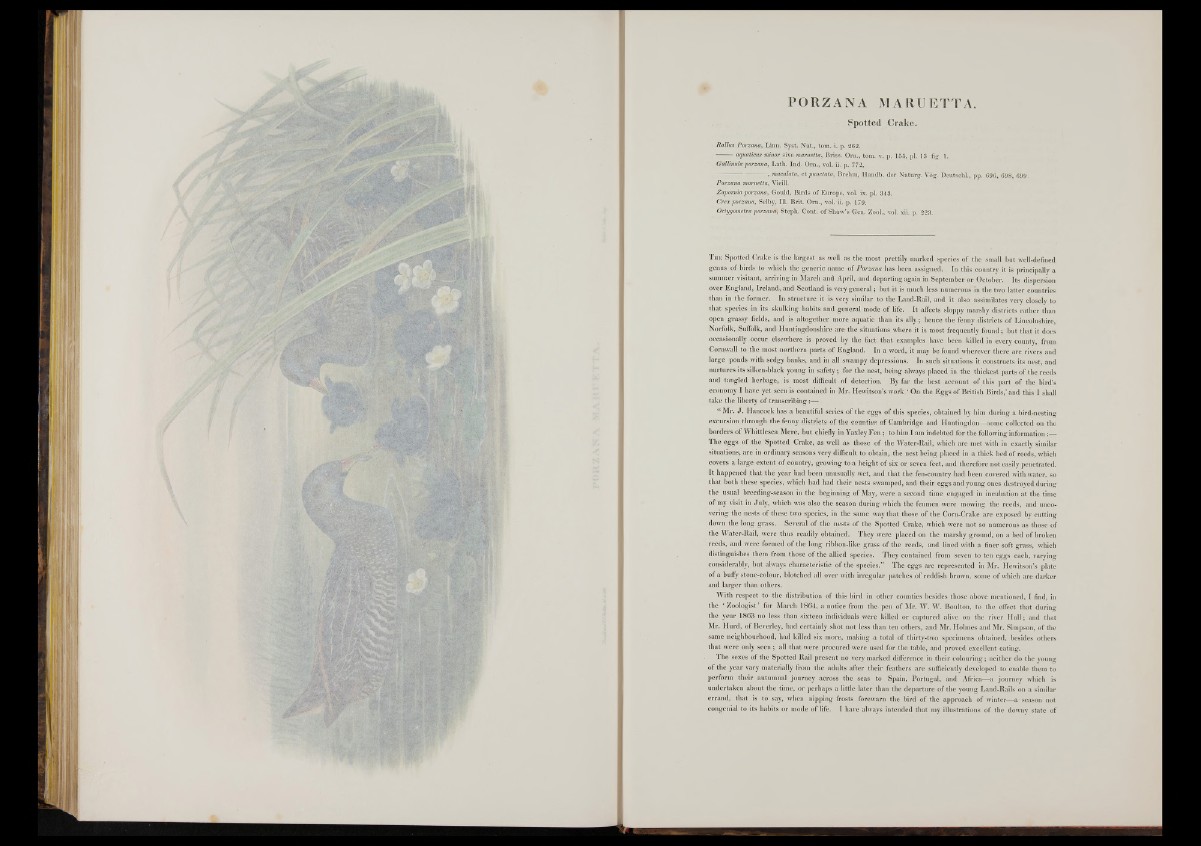
Spotted Crake.
Rallus Porzana, Linn: Syst. Nat., tom. i. p. 262.
; aquaticus minor sive maruetta, Briss. Ora., tom. v. p. 155, pi. 13 fig. 1.
Gallínula por zana, Lath. Ind. Orn., vol. ii. p. 772.
, maculata, et punctata, Brehm, Handb. der Naturg. Vog. Deutschl., pp. 696, 698, 699.
Porzana maruetta, Vieill.
Zapomia porzana, Gould, Birds of Europe, vol. ix. pi. 343.
Crex porzana, Selby, 111. Brit. Orn., vol. ii. p. 179.
Ortygometra porzanfy Steph. Coat, of Shaw’s Gen. Zool., vol. xii. p. 223.
T he Spotted Crake is the largest as well as the most prettily marked species of the small but well-defined
genus of birds to which the generic name of Porzanahas been assigned. In this country it is principally a
summer visitant, arriving in March and April, and departing again in September o r October. Its dispersion
over England, Ireland, and Scotland is very general; but it is much less numerous in the two latter countries
than in the former. In structure it is very similar to the Land-Rail, and it also assimilates very closely to
that species in its skulking habits and general mode o f life. It affects sloppy marshy districts rather than
open grassy .fields, and is altogether more aquatic than its ally; hence the fenny districts of Lincolnshire,
Norfolk, Suffolk, and Huntingdonshire are the situations where it is most frequently found; but that it does
occasionally occur elsewhere is proved by the fact th at examples have been killed in every county, from
Cornwall to the most northern parts o f England. In a word, it may be found wherever there are rivers and
large ponds with sedgy banks, and in a ll swampy depressions. In such situations it constructs its nest, and
nurtures its silken-black young in safety; for the nest, being always placed in the thickest parts of the reeds
and tangled herbage, is most difficult of detection. By far the best account o f this part of the bird’s
economy I have yet seen is contained in Mr. Hewitson’s work ‘ On the Eggs of British Birds,’and this I shall
take the liberty o f transcribing
“ M r. J . Hancock has a beautiful series of the eggs o f this species, obtained by him during a bird-nesting
excursion through the fenny districts of the counties of Cambridge and Huntingdon—some collected on the
borders o f Whittlesea Mere, but chiefly in Yaxley F e n ; to him I am indebted for the following information:—
The eggs of the Spotted Crake, as well as those of the Water-Rail, which are met with in exactly similar
situations, are in ordinary seasons very difficult to obtain, the nest being placed in a thick bed o f reeds, which
covers a large extent o f country, growing to a height of six: or seven feet, and therefore not easily penetrated.
I t happened that the year had been unusually wet, and that the fen-country had-been covered with water, so
th at both these species, which had had their nests swamped, and-their eggs and young ones destroyed during
the usual breeding-season in the beginning o f May, were a second time engaged in incubation a t the time
of my visit in July, which was also the season during which the fenmen were mowing the reeds, and uncovering
the nests o f these two species, in the same way that those of the Corn-Crake are exposed by cutting
down the long grass. Several o f the nests o f the Spotted Crake, which were not so numerous as those of
the Water-Rail, were thus readily obtained. They were placed on the marshy ground, oh a bed of broken
reeds, and were formed of the long ribbon-like grass o f the reeds, and lined with a finer soft grass, which
distinguishes them from those of the allied species. They contained from seven to ten eggs each, varying
considerably, but always characteristic of the species.” The eggs are represented in Mr. Hewitson’s plate
of a buffy stone-colour, blotched all over with irregular patches of reddish brown, some of which are darker
and larger than others.
With respect to the distribution of this bird in other counties besides those above mentioned, I find, in
the ‘ Zoologist’ for March 1864, a notice from the pen o f Mr. W. W. Boulton, to the effect that during
the year 1863 no less than sixteen individuals were killed or captured alive on the river Hu ll; and that
Mr. Hurd, o f Beverley, had certainly shot not less than ten others, and Mr. Holmes and M r. Simpson, o f the
same neighbourhood, had killed six more, making a total o f thirty-two specimens obtained, besides others
that were only seen ; all that were procured were used for the table, and proved excellent eating.
The sexes o f the Spotted Rail present no very m arked difference in their colouring; neither do the young
o f the year vary materially from the adults after their feathers are sufficiently developed to enable them to
perform their autumnal journey across the seas to Spain, Portugal, and Africa—a journey which is
undertaken about the time, or perhaps a little later than the departure of the young Land-Rails on a similar
errand, that is to say, when nipping frosts forewarn the bird o f the approach o f winter—a- season not
congenial to its habits or mode o f life. I have always intended that my illustrations of the downy state of